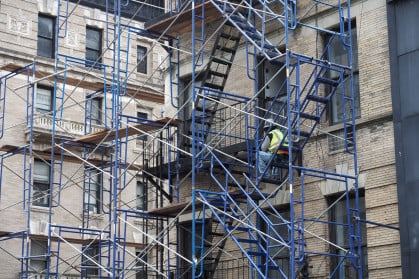5 ways to encourage shareholders or owners to run for your co-op or condo board
- Encourage residents to join committees to test out their leadership ability
- Appoint a replacement if a board member leaves in the middle of their term
- Look for potential board members with expertise and people skills

Residents can get a sense of the board's operations by joining a committee.
iStock
If your New York City condo or co-op building is struggling to fill a vacancy on the board, you might actually be doing something right.
It may seem counterintuitive, but the best-run buildings often have trouble filling board positions because residents don’t see a need to disrupt the status quo. Ironically, that leaves boards with a lot more work to do to convince residents to run for open seats.
Vacancies are not uncommon at NYC boards, says Will Kwan, a managing partner at EZ Election Solutions, which advises buildings on elections and annual meetings. Usually, shareholders and owners only get involved when they feel the current board is doing a poor job of managing their building, says Mark Feinberg, chief financial officer of Argo Real Estate and president of his own cooperative near Union Square.
“Typically, the reason people run for the board is that they're dissatisfied with the current way things are run by the board,” Feinberg says. “You get opposition because the current board is either raising maintenance or somebody has beef or something like that.”
Luckily, there are a handful of tactics your board can use to encourage residents to run for open seats, outside of starting a building controversy.
The easiest and most crucial step is to explain what the role is and why it’s important. From there, board members can encourage residents to join committees, recruit specific candidates, and let residents know when seats open up. Retiring board members can even appoint specific replacements if they plan on leaving before an annual election.
Read on for five steps to encourage residents to run for your board.
Explain the role and its importance
For most residents, their apartment is more than just their home—it’s likely their largest financial investment. One of the easiest ways to convince a resident to run for their board is to outline how the position could help them protect that stake.
“This is the biggest investment you have,” Kwan says. “You want to control the direction [it] goes in.”
It may be easier to recruit residents with more shares or an owner with a larger unit because more of their wealth is tied up in the building.
“The bigger your investment, the more involved you should be,” says Adelaide Polsinelli, a commercial broker at Compass, and former board president of her co-op building in Greenwich Village.
Your board should also explain how often they meet, what large projects they are working on, and the role’s time commitment. You can explain the board’s responsibilities in person or give an interested resident some introductory documents, if you have them.
Mark Levine, principal at property manager EBMG, keeps a document outlining common questions about condo and co-op boards that he distributes to newly elected board members. He’ll occasionally send the packet out to potential recruits so they have an understanding of the job.
Potential board members tend to hesitate because of the amount of work, Levine says. Most residents should expect to spend around 10 hours per month on the position, including monthly board meetings, though time commitments will vary by building. While you might not want to focus on the more contentious or lengthy meetings when approaching a new recruit, giving them an honest picture of the board is important if you want them to stick with it.
But you may want to stop short of inviting recruits to sit through board meetings, Kwan says.
“We have had people shadow us, where we said, ‘come to board meeting see how you like it,’ and after that they decide they don't want to do it,” Kwan says.
Would-be-board members are also often concerned that they could be held personally liable for a board’s decisions, Levine says. But members should not be held liable as long as they act in good faith to reasonably carry out their duties, and your building should have liability insurance for its board members.
Committees for the commitment-phobes
Committees are a great way for residents to dip their toes into building leadership without serving on the board.
Polsinelli served on her building’s gym, Christmas, and Halloween party committees before she ran for board president. And after she was elected, she used committees as a pool of potential candidates for open board positions.
Committees also allow board members to identify residents that they work well with and weed out those who just want to tackle a single project.
“The worst thing you can have is if a person is on the board for one issue and not willing to contribute to any other issue,” says Corinne Arnold, a managing partner at EZ Election Solutions.
Even if a committee member doesn’t end up running for a board seat, your building has still gained a great resource on a smaller issue, Arnold says.
“Committees are a two-way street because you can groom people and tap into people that don’t have time for the board,” Arnold says.
Recruiting season
Never underestimate the power of a good compliment. When speaking to individual residents that you think should run for the board, it’s worth being specific as to why they’d be a good fit, Arnold says.
“[For example], I’ll say ‘you're a great negotiator, we think you could handle this very difficult strategic negotiation,’” Arnold says.
She also recommends recruiting residents from diverse backgrounds and professions. Finding someone with construction experience is definitely a plus, Arnold says.
“It's always amazing if you can have an architect or an engineer, that's like gold,” Arnold says. “You can't beat that because they're knowledgeable in the area you are working in.”
Arnold, Kwan, and Feinberg all recommend board members keep an eye out for potential recruits in board interviews. Kwan recalls interviewing a lawyer who bought a combined apartment in his building, who mentioned that he may be interested in joining the board in a couple years. Just a year later, Kwan had convinced him to run for and win a seat on the board.
Communication is key
Regularly communicating with residents will both keep your board transparent and let shareholders or owners know when board posts are opening up.
Your board can use building-wide communications—such as an email or a newsletter—to keep residents updated on board projects and remind them of opportunities to contribute, either through a committee or by serving on the board themselves. (Kwan started a communication committee in his own building, made up of both board members and shareholders, which created a building-wide newsletter).
Your board is also likely required to send out a call for nominations for different board positions no more than 60 days before your annual election, though the timeline will depend on your building’s bylaws.
Appoint a successor
If a board member is leaving their seat in the middle of their term, the board can appoint a successor to hold the position until the building’s annual election. An appointment is a useful way to replace a member who had to leave unexpectedly, Levine says.
“If it’s between annual meetings, typically the board has the power to appoint who they would [want] to [serve on] the board for the remainder of the term that was vacated,” Levine says. “In those cases, they’ll reach out to somebody who has probably run in the past, or who has attended annual meetings, or maybe someone who is a friend or a neighbor and says they want to get involved.”
This strategy has been used in Kwan’s building, particularly during years where there’s not a lot of interest from residents on serving on the board. Appointments tend to make the process a lot easier, particularly if the board has a good fit in mind, Levine added.
Sign Up for our Boards & Buildings Newsletter (Coming Soon!)
Thank you for your interest in our newsletter. You have been successfully added to our mailing list and will receive it when it becomes available.




















